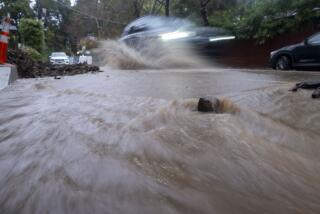High-Tech Eye on the Sky
- Share via
They look like old-fashioned stovepipes, these metal cylinders perched atop poles and rooftops.
Some people use them for target practice. Most people ignore them. Golfers at one Newport Beach course strolled right by a cylinder one recent morning, never looking up, never puzzling why a stovepipe might be equipped with an antenna.
Few suspect that these contraptions are in fact high-tech sentries, part of a far-flung early-warning system designed to detect--not enemy missiles or wayward bombers--but just how much rain is falling on Orange County.
An elaborate network of 63 rain gauges is used by weather experts to measure rainfall from Brea to Seal Beach to San Clemente to Santiago Peak.
In fact, the county rainfall totals that residents read in the newspaper or watch on television are often gleaned from data collected by these gauges.
But the network also allows county officials to take the pulse of local storms--and to react swiftly when water levels rise and flooding is threatened.
“It’s activated 24 hours a day, 365 days a year. It’s always on,” said Lane Waldner, environmental studies supervisor in the county’s Public Facilities and Resources Department.
Still, it is during the winter rainy season that county officials scrutinize the data most. January, for instance, is the wettest month, averaging 2.80 inches, and January 1995 was the rainiest on record, with 12.86 inches.
The gauges themselves are cylinders about 1 foot in diameter, cradling a rain-measuring device and a mechanism that stores and transmits information by radio.
The data travel to an antenna on Santiago Peak and then to the so-called “storm center” at county offices in Anaheim, where weather information is monitored.
There, county employees can use computers to study a colorful electronic map of the rain-gauge system, noting just how much rain is falling in different sections of the county.
With the flick of a switch, Waldner could call up a computer map from 8 a.m. on Jan. 23 that reveals a storm dumped more than 4 inches of rain at Santiago Peak, compared with 1.54 inches around Buena Park and La Habra and only 0.16 inches near Dana Point.
The network, known as the ALERT--Automated Local Evaluation in Real Time--system, lets county officials track storm intensity and gives them early notice of impending problems such as flash floods. They are assisted by a separate system of sensors that monitor stream levels throughout the county. During wet winters like this one, such information is especially important.
*
After January’s soggy weather, Waldner said, “We’re concerned now that if we do get heavy rainfall [in February], the ground is supersaturated.”
Orange County’s rainfall data are also sent automatically to a computer at the National Weather Service, where the figures are used to complement other readings such as those from the new state-of-the-art Doppler radar installed last year in the Cleveland National Forest.
“We depend heavily on the rain-gauge data,” said Armando Garza, meteorologist at the weather service’s office in San Diego.
Keeping the network up and running can sometimes cause headaches. Batteries can go dead in hard-to-reach mountain gauges. And then there are the vandals--like those who use the gauges for target practice, peppering the metal sides with bullets and wreaking havoc with the delicate technological innards.
Gauges in the Santa Ana Mountains foothills are especially susceptible, officials said. So they have started burying part of the gauges in dirt, making sure the electronic “brains of the system” are safe from whizzing ammunition.
(BEGIN TEXT OF INFOBOX / INFOGRAPHIC)
Rain Line The history of rainfall in Orange County is recorded by season, which runs from July 1 to June 30. Santa Ana season totals in inches from June 1, 1908, the earliest date. Total for 1996-97 through Jan. 31:
Water Marks (Data in inches)
Wettest season 1940-41: 32.14
Driest season 1960-61: 3.57
Average season: 13.01
Wettest month (avg.) January: 2.80
Driest month (avg.) July: 0.01
Average month: 1.08
Wettest single month January 1995: 12.86
Measure for Measure The Public Facilities & Resources Department measures rainfall at approximately 65 stations around the county. Instruments are housed in 12-inch diameter aluminum cylinders. How the sensors work:
Systems Senors
1. Funnel collects water, drains into tipping bucket.
2. When .04 inches of rain fills one side of bucket, it tips, dumping rain and activating switch that transmits signal to relay station on Santiago Peak and back to Public Facilities & Resources Department computer in Anaheim.
3. Rain fills other side of bucket; process repeats.
4. If rainfall exceeds certain level in predetermined time period, computers signals turn red.
1990s: 13.33*
* Figure is for 1996-97 season through January.
Source: County of Orange, Public Facilities & Resources Department
More to Read
Sign up for Essential California
The most important California stories and recommendations in your inbox every morning.
You may occasionally receive promotional content from the Los Angeles Times.













